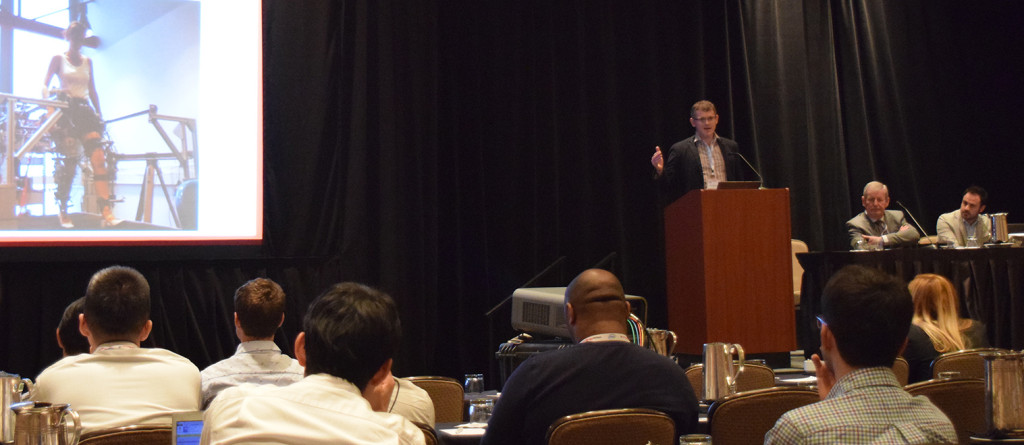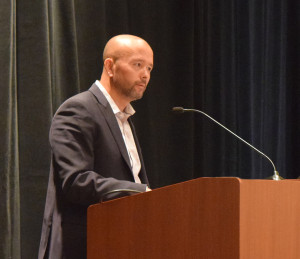The first Wearable Robotics Association Convention, WearRAcon16 wrapped up on its 3rd and final day. Unfortunately, all good things must come to an end and so did the largest gathering of exoskeleton and wearable robotics researchers, engineers, evaluators and potential buyers. WearRAcon16 Day 3 had one general session and four information-laden breakout sessions to choose from. This was in addition to the delicious breakfast and extended lunch that provided attendees another chance to network and establish connections.
The first breakout session was on ergonomic issues of wearable robotics. The presentation included members of the Army Research Lab which had a unique perspective on the subject. The Army straps exoskeletons on their soldiers not for 1 hour lab sessions but for 6 hour long hikes. A slight pinch or discomfort that may have been tolerable in a 1 hour test session becomes a big sore after 6 hours of using the same exoskeleton. Overall, this presentation was a great reminder why there are many academic and commercial entities with completed exoskeletons for industrial use, but are not releasing much information until they have finished thorough testing and validation of their designs.

Another great presentation during WearRAcon16 Day 3 was on the difficulty of controlling multi-joint powered prosthetics and powered orthotics. While researchers universally have become better at controlling single actuation devices, controlling two or more joints on the same leg at the same time is still problematic. Currently, an actuated knee-ankle artificial leg can take hours if not days to fine-tune. In other words, the prosthetic leg will move the user forward, but the trajectory of the leg will deviate from the normal. One of the presented solutions was to enslave the knee and ankle actuators to the angle of the thigh which moves consistently even while walking on different surfaces (asphalt, gravel, dirt, etc). An interesting comment made was that such systems are greatly limited by differences in walking between men and women, limiting the anatomical points that can be used to create this master-slave control relationship.
One of the sessions was dedicated to cybersecurity in wearable robotics. The US military has spent a great deal of time and effort over the last two years securing its drones and electronic equipment from hacker attacks. Powered wearable devices share some of the same weaknesses as more and more of the sensors and controllers use wireless communications. If an enemy can detect the location of exoskeleton devices used in the military it would give the location of the users away. In the future any non-passive exoskeletons intended for medical (medical information is protected by law), industrial and military use will have to go through more security upgrades before deployment.

After a great lunch with plenty of networking opportunities, the WearRAcon16 group came together one last time for a presentation on wearable robotics in Europe. It appears that the Europeans have not been idle over the last few years. Even if the session was three times longer there still wouldn’t have been enough time to go over all of the material in detail! In summary, millions of Euros have been spent not only on developing new exoskeleton devices that help people, but ones that hinder users as well. Yes! All makes of devices that hinder walking, disturb the balance of the user in every direction or test platforms that slide under the user were presented. There is an enormous interest in the EU on understanding walking in greater detail. Over multiple research projects and thousands of experiments, European research labs are developing better mathematical models on the human gait and how we correct or stance during a slip or loss of balance. It is hoped that all of this research will lead to a better understanding of the fundamentals of human movement which will then lead to a new generation of superior wearable robotics.

Dr. Joseph Hitt gave the closing remarks to the conference, vowing that the Wearable Robotics Association will continue working on bridging the global community and that we will all reconvene at the same place in March of 2017. With this, WearRAcon16 Day 3 and the entire conference came to an end.
Filing out of the conference grounds I was wondering if I can summarize how people felt about this 3 day experience in one sentence? There were some complaints. Some attendees were left surprised by how heavily the presentations were geared towards engineers, while others wanted more information on the different products and performed studies. At the end, everyone was unanimous in one comment: no one knew how much work has already been done. When people concentrate on their own projects it is understandable if they don’t have the time to look for relevant news. However, even groups that try to keep up to date on the news were astonished by how many projects they were seeing for the first time. The ExR team was also left surprised at the number of exoskeletons we have skipped in 2015, and this doesn’t even take into consideration all of the groups that didn’t make it to WearRAcon16.
Before I was very skeptical by the claims by the Wearable Robotics Association that exoskeletons are going to explode on the market in 5 years, similar to the way drones have proliferated. After WearRAcon16, I wonder if it will even take 5 years or if it will be sooner?
Special thanks to the Wearable Robotics Association Staff: Carolyn Lagermasini, Amy Gallagher, Executive Committee: Joseph Hitt, Bruce Floersheim, Thomas Sugar, Philip Sugar and Advisory Board: Russ Angold, José Pons and Gurvinder Singh Virk for putting together WearRAcon16! You can find more information about them and the event at their website.
Also a special thank you to the Arizona Grand Resort & Spa for their incredible accommodations, food and service. They did an amazing job hosting WearRAcon16, and we’re looking forward to having WearRAcon17 there next year!
If you already haven’t done so, make sure you check out the reports for Day 1 and Day 2 of WearRAcon16.








Add Comment